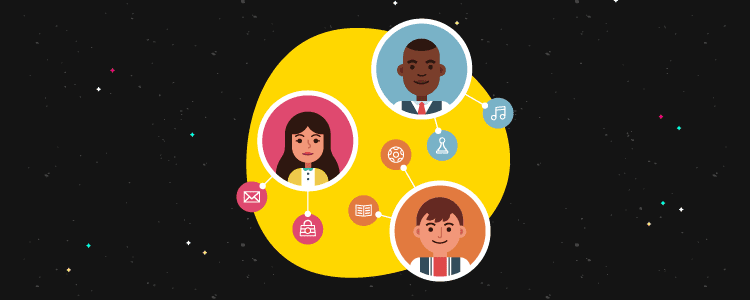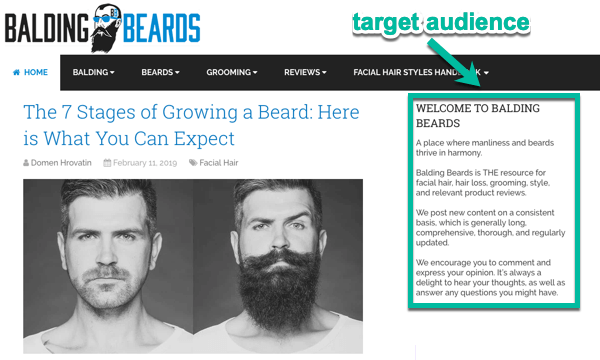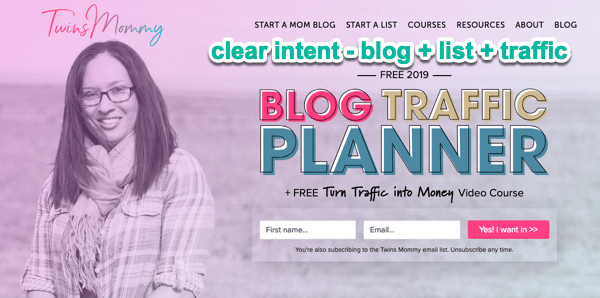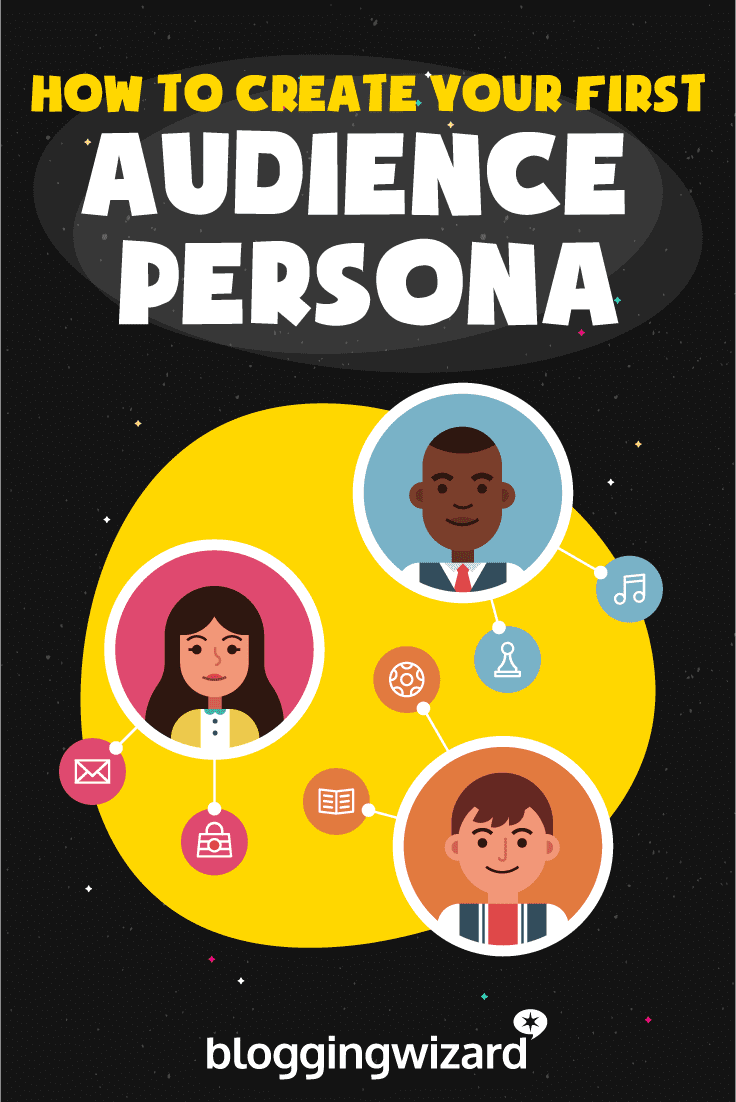How To Define Your Target Audience And Create Your First Audience Persona

When you’re starting a new blog, most of the standard advice revolves around choosing your niche.
And that’s OK. It’s a valid exercise.
But it’s not the only thing to consider.
You have to think about who is going to read your blog content; i.e. your target audience.
In this article, you’ll discover why you need to define your target audience and how to create your first audience persona.
Ready? Let’s begin.
What is a target audience for a blog?
A blog’s target audience is the group of people with shared characteristics who will find its content most helpful.
Questions to ask yourself are:
- Who is my target reader?
- Who am I helping, educating or entertaining?
- What am I helping them with?
- What are their day-to-day concerns?
- What will my unique angle be?
- How will you use your strengths and interests to help your readers and make you stand out from similar blogs?
These questions help you form a crystal clear mission statement that you can use on your blog.
For example, Elna Cain is a successful writer and blogger who runs several blogs. But each one is directed towards a different target audience.
For Twins Mommy, she says:
Twins Mommy is a place to help moms make money blogging. I provide help to increase your website traffic, email list, and income and turn your blog into a business that thrives.
- The target audience is moms who want to become mompreneurs. They can be stay-at-home moms, working moms or mommy bloggers.
- Elna’s unique angle is to help them to increase their blog traffic and grow their email list before generating income.
But for her freelance writing blog, Elna Cain, the target audience is different:
This site is dedicated to helping you become a successful professional writer. It’s a place where I share my experiences as a freelance writer and help you get started.
- The target audience is people (of any age or sex) who want to become freelance writers.
- Elna’s unique angle is to help writers find their first freelance writing job, and go on to make a living from it, by sharing her personal experiences as a freelance writer.
It’s a good idea to tell readers what your blog is about, either on your Homepage or About page, to ensure you have the right audience.
Why you need to define your target audience
There are three benefits to defining your target audience:
#1 – Ensure you’re creating the right content, for the right people
When you know your target audience, you can create content that’s going to resonate with them. That includes choosing the right topics and presenting it in an appealing way; i.e. choosing the right blog theme and color scheme.
Compare and contrast the content and branding of Balding Beards and Twins Mommy.
Balding Beards has blog posts on their homepage alongside a mission statement about their target audience:
A place where manliness and beards thrive in harmony. Balding Beards is THE resource for facial hair, hair loss, grooming, style, and relevant product reviews.
The colors and styling are dark and straight to appeal to men.

Twins Mommy has a different homepage format with links to starting a blog, building a list, and generating traffic. And as it’s intended for moms, the color and styling are lighter:

#2 – Understand how to create content that connects with audience needs
On Twins Mommy, Elna creates content for moms for who want to make money blogging.
She doesn’t write about ‘cupcake recipes for moms’ or ‘parenting advice for moms with teenage kids’. It’s not what her audience wants to know.
She writes actionable content on relevant topics like starting a blog, list building, and making money.
Balding Beards is also clear on its audience and purpose. Their informational content focuses on ‘manly’ topics like balding, beards, and grooming.
#3 – Increase conversions and monetization of products
When you follow steps 1 and 2, then you’ll increase your conversion rates and get more readers subscribing to your email list.
Your audience knows you deliver content that meets their needs, so they’re more likely to spend money with you, either by clicking your affiliate links or buying your products.
Defining your target audience is a great start.
But you can go one step further, and get better results when you create an audience persona.
So what’s the difference between a Target Audience and an Audience Persona?
Let’s take a look.
What is an audience persona?
An audience persona – sometimes called an avatar – is a fictional representation of someone in your target audience. By applying some real-life characteristics, it helps you create content with a specific person in mind.
You can have more than one audience persona for your target audience to represent the different types of people. Most bloggers create 2-3 personas.
Why you need audience personas
Audience personas give you a deeper understanding of your target audience. For example, you can:
- Identify their pain points, challenges, needs, and desires.
- Understand what they care about and what they’re interested in.
- Discover where they spend their time.
It’s easier to speak to a person rather than a list of data points.
For example, we know that Elna’s target audience for Twins Mommy is: Moms who want to make money blogging.
But with an audience persona, we can go deeper.
For example, she may create a persona like this:
Steph is 45 and mom to teenagers Dan and Chris. She has time in the day and wants to build an online business to bring additional income to the household. She needs help in setting up a blog and attracting visitors to get her business started.
- Now we have a picture of a mom who wants to make money blogging. She has a fixed amount of free time in the day that she can dedicate to building her online business.
- Notice how the persona also has a name – Steph. This helps you remember each character when you’re creating content; e.g. “I’m going to write a blog post that’s intended for Steph.”
You can go as detailed as you need when creating your audience personas. In the next section, we’ll look at the questions and data you can compile to build your first audience personas.
How to create your first audience personas
There are lots of questions you could ask when creating your audience persona. But to get you started, we’ve listed the essentials. (You can always add more later if you want to be more specific.)
There are three sections to building your audience persona:
- Demographics – Their general background details.
- Goals and challenges – What your audience persona wants to achieve and how you can help them.
- Online activities and preferences – How they like to consume content.
Let’s check them out:
#1 Demographics
- Sex – Is your ideal reader a man or a woman?
- Age – How old are they?
- Location – Where do they live?
- Education – What is their level of education?
- Employment – Are they currently working?
- Income – What is the estimated level of annual income?
- Leisure – What other hobbies and interests do they have?
- Marital status – Are they married?
- Children – How many kids do they have?
#2 Goals and challenges
- Goals – What is their key goal that you can help them with?
- Challenges – What is their problem that you can solve?
- Blocks – What is keeping them from solving this problem?
- Values – What’s important to them?
- Motivation – What motivates them?
- Dreams – What are their dreams and aspirations?
#3 Online activities and preferences
- Format – What content format do they prefer (e.g., video, text, audio)?
- Frequency – How often? (an hour a week? an hour a day?)
- Length – What length of content do they prefer?
- Social media – Which social media platforms are they active on?
- Blogs/podcasts – Which blogs and podcasts do they subscribe to?
- Forums/groups – Which online communities or forums do they actively take part in?
By answering each question, you build up a picture of a character. So the final thing you must do is:
Give them a name.
Here are the answers for our fictional character Steph:
#1 Demographics
- Sex – Female
- Age – 45
- Location – Palo Alto, California
- Education – College
- Employment – No, she’s a housewife
- Income – None, not working
- Leisure – Knitting, surfing
- Marital status – Yes, married to Ryan
- Children – 2 teenage boys
#2 Goals and challenges
- Goals – Wants to start an online business
- Challenges – Not sure how to start and grow the business
- Blocks – Read articles elsewhere but not convinced about the advice
- Values – She wants clear guidelines to follow
- Motivation – She wants to prove they can build a business
- Dreams – To generate additional income so they can travel to Europe
#3 Online activities and preferences
- Format – Text and video
- Frequency – An hour a day
- Length – Around 2000 words
- Social media – Facebook, Instagram, Pinterest
- Blogs/podcasts – Melyssa Griffin, Smart Passive Income
- Forums/groups – Facebook group for knitting inspiration
When you’ve answered all the questions, you can summarize the information in a couple of paragraphs, like so:
Steph is 45, married to Ryan, and mom to teenager boys Dan and Chris. They live in sunny California in the town of Palo Alto. Steph enjoys surfing and knitting.
With the boys at college, she has free time in the day. Steph wants to build an online business to bring additional income to the household, as she’d like to save up some money to start traveling around Europe.
She needs help in setting up a blog and attracting visitors to get her business started. Most content she’s read is lightweight. She’s looking for step-by-step guides that are easy-to-follow so she can get the basics right and build from there.
Steph is active on social media and favors Instagram and Pinterest as they’re both image-centric and ideal for her knitting and crafts hobbies. She follows the big name blogs of Melyssa Griffin and Pat Flynn, but would like a more down-to-earth blogger to follow and trust.
For a final touch, why not add a photo or character, so the audience persona is more recognizable?
To help you work through this process for your target audience, we’ve created a handy spreadsheet where you can record your answers for each persona you create. Grab your copy below.
Wrapping up
Taking the time to define your target audience and create an audience persona will help you start your blog on the right footing.
It’ll help you create persona-driven content that reaches the right people, so you gain more traction and engagement.

